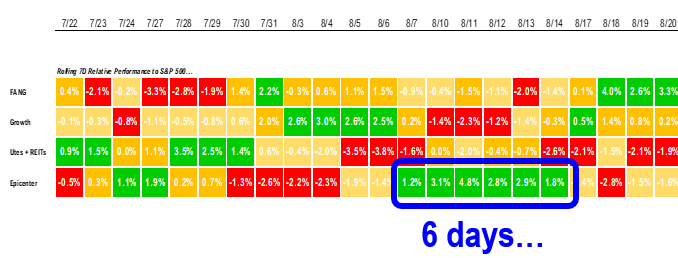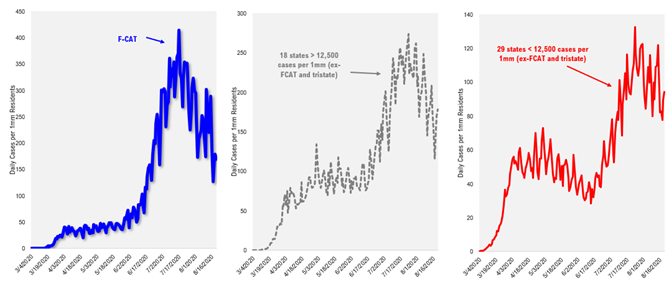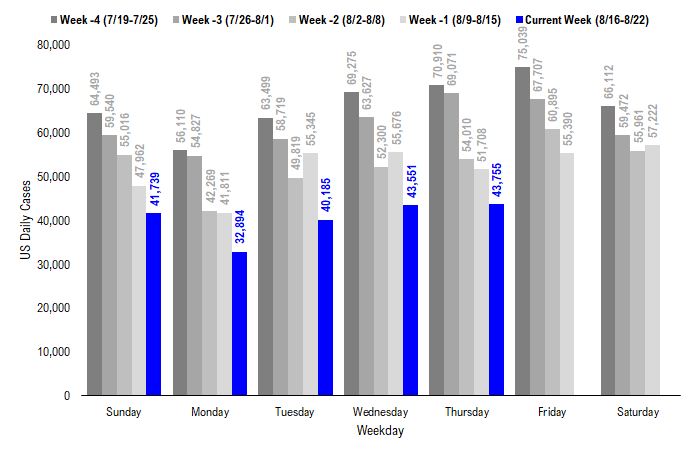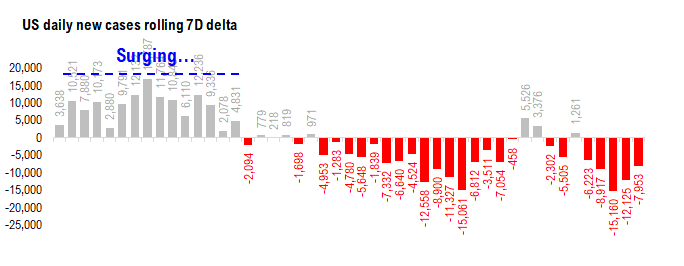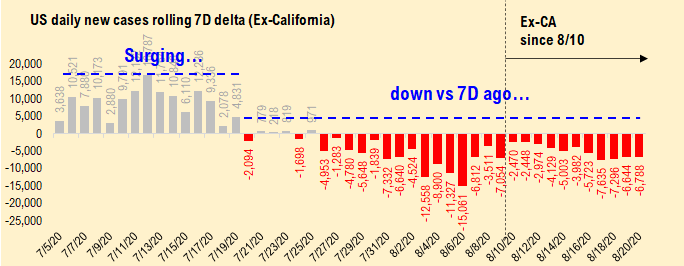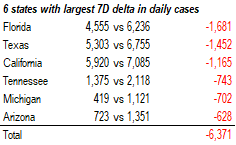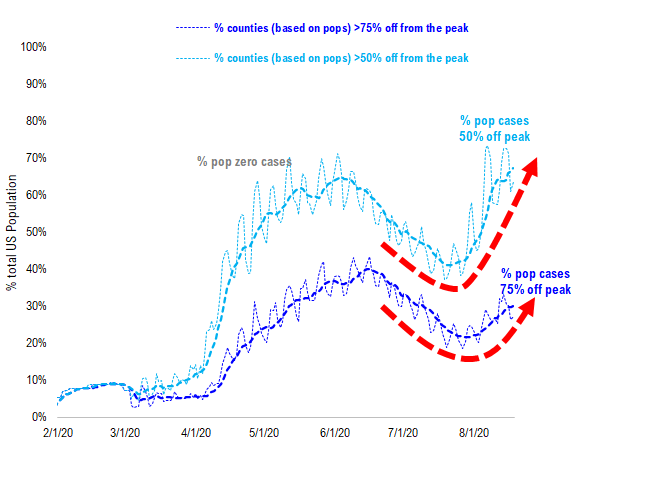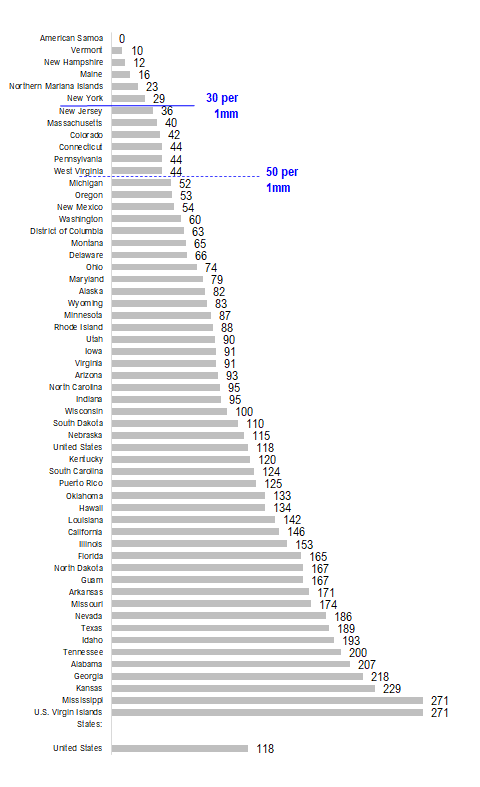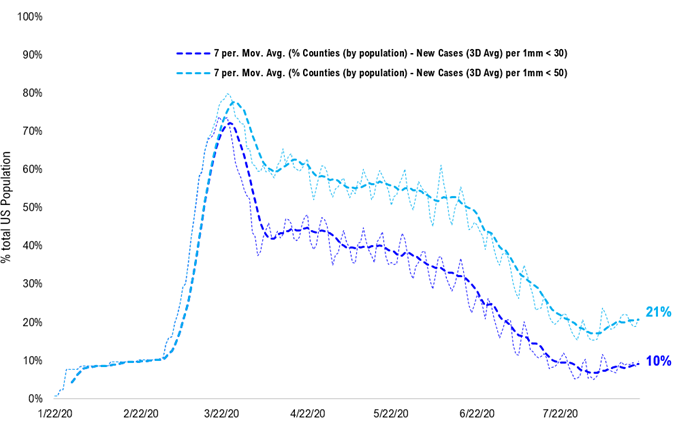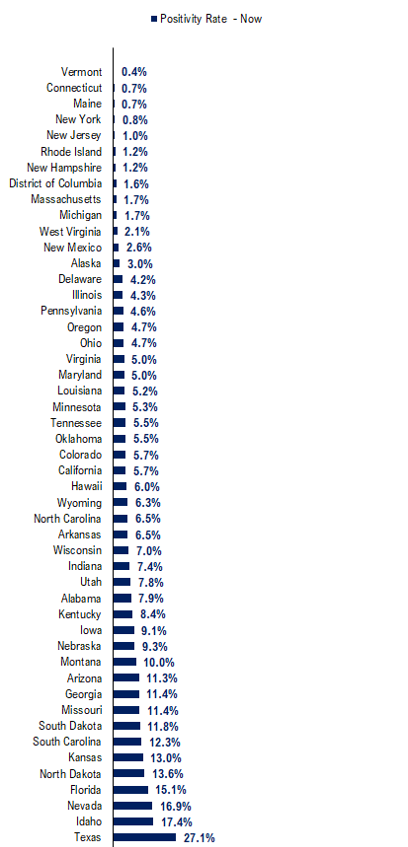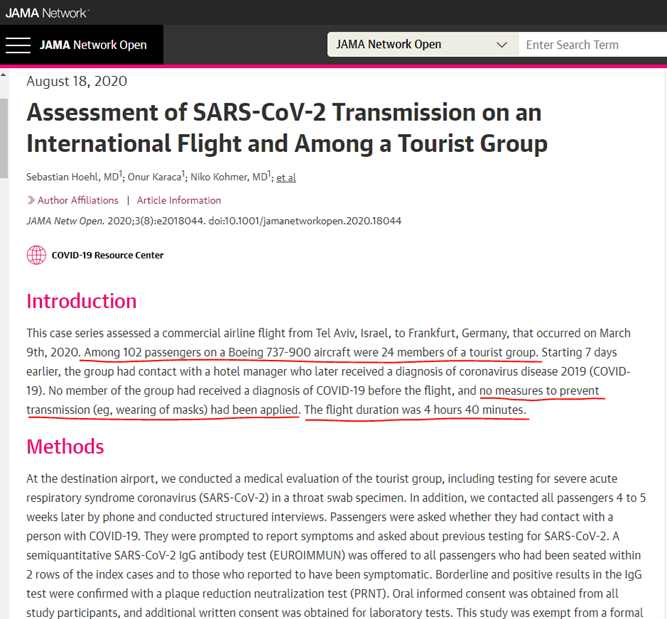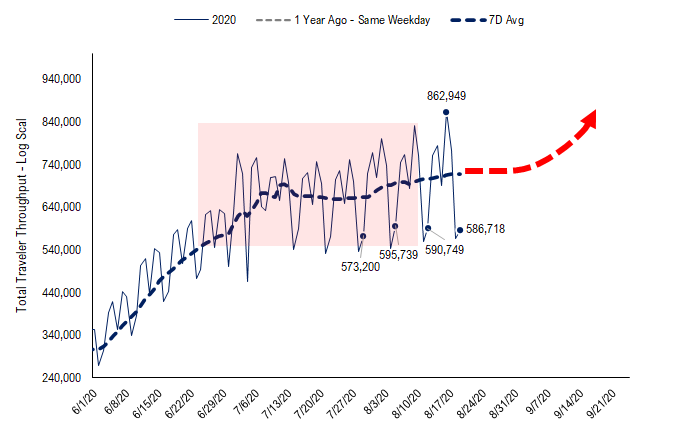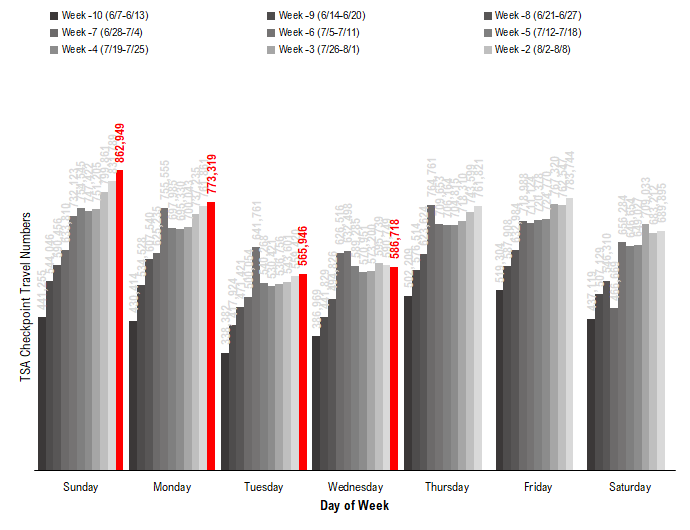Click HERE to access the FSInsight COVID-19 Daily Chartbook.
STRATEGY: Markets not convinced economy regaining footing…
This has been a very good week for US COVID-19 case data. After all, trends this week cement that the trend is downwards for organic case growth. But we also think that markets will start to shift their thinking about COVID-19 from “change in cases” to “level of cases.” That is, we will start to focus more on the question of “when is COVID-19 under control” in the US.
The benchmark many cite is a positivity rate <10%, but the current rate is 6.5% and it doesn’t seem like COVID-19 is under control. We think a better measure is to look at daily cases per 1mm residents — it is currently ~120 per 1mm (40,000 per day). Europe did not open until daily cases 30-50 per 1mm, which in the US equivalent is 9,900 to 16,500.
– so cases need to fall another 60% from here –> at this pace of change, we could be there in a few weeks
– only 10 states have <50 cases per 1mm and only 4 <30 per 1mm (NY, VT, ME, NH)
– only 21% of counties have <50 cases per 1mm, or 1/5 of the US has COVID-19 under control.
So the US has a ways to go. But the interesting thing is the cases are falling so rapidly, we could see these levels in a few weeks.
The quilt below shows the trailing performance (7D relative to S&P 500) of 4 cohorts driving the S&P 500:
– FANG
– Growth
– Defensives
– Epicenter
And as you can see below, the last 3 days have been dominated by the relative outperformance of FANG. And the outperformance of the “epicenter” stocks was a 6-day story, 8/7 to 8/14. This was shorter than the 10-day outperformance in May timeframe.
Source: Fundstrat
If I had to point to the primary drivers behind this weakening outperformance, three issues seem to come to the forefront:
– first, US economy seems “stuck in neutral” because Americans are still worried about COVID-19 (correctly)
– second, Europe is seeing a resurgence of cases, so there is this “second wave” fear, especially back to school and flu season in US
– third, Washington is still dawdling on a CARES Phase 4, and DNC this week is only highlighting how contested 2020 elections will be
So, this is fear that the progress in US cases is only temporary and will soon worsen in the Fall. And the economy therefore suffers. This is a natural expectation. And the future is uncertain.
However, given the mitigation steps taken by local policymakers and citizens, we are seeing a rapid organic retreat in cases. I cannot fully explain this, but as shown below, this drop in cases is happening throughout the US and at the same pace. So, this is not a sequence of outbreaks. The existing surges are all beginning to wind down.
Source: Fundstrat
And I think this news story below is a pro-epicenter story. Wynn is redirecting stock grants, originally targeted for its CEO, to be given to its top performers. It is essentially a retention bonus and targeted at the top 240 employees. The details are in the article below. Wynn is not doing this out of a position of strength, but think about what this means for its employees in 12 months.
If a vaccine/cure happens, or if cases retreat, Americans will feel safe leaving their homes. Wynn’s stock likely performs prodigiously as a result. And it will make its top employees’ grants even more valuable. This is skin in the game, and a shrewd strategic move — thinking beyond the chaos and mess of the current economic Depression.
https://www.cnbc.com/video/2020/08/20/wynn-approves-stock-grant-to-motivate-key-employees.html
POINT 1: Daily cases at 43,755, which is -7,953 vs 7D ago…
Daily cases continue to show organic improvement, at 43,755 which is down -7,953 vs 7D ago. There is still some distortion coming from an apparent backlog in TX, and CA was distorting data for the better part of the past 10 days.
– typically within a week, Wed/Thu/Fri cases are the high watermark for the week.
– thus, if cases are peaking in the low 40s this week, we expect them to fall towards 30k-ish next week
– and possibly fall into the 20k level by the end of August
Source: COVID-19 Tracking Project
The 7D delta remains the best measurement for tracking case progress and the distortions from the CA backlog still appear. We can see this by comparing the 7D delta with and without CA. Still, the trend is clear. Cases are falling rapidly.
Source: COVID-19 Tracking Project
Source: COVID-19 Tracking Project
POINT 2: LEVEL VS CHANGE: Cases way down but US ways to go before COVID-19 risk “low”
When discussing COVID-19 progress, we mostly comment on the “change” in the data, and less on the “level”
– change measures the pace of spread
– level (absolute) is a measure of the “control” of the virus.
And as we discuss below, the change in case trends is very good. But the level of cases remains too high. And a rough measure is a level of new daily cases below 50 per 1 million is considered “controlled” level of spread. Currently, daily cases in the US are ~40,000 per day, or ~120 per 1mm residents. Thus, daily cases need to fall to around 16,000 per day to be “controlled”
CHANGE –> Daily cases are way off their highs…
The trend in US cases relative to its peak is positive. But this is a “change measure” and we can measure how many counties (based on Pops) are seeing cases 50% and 75% off their peaks.
– counties with cases 50% off their peak is at a new high, surpassing even what we see in April/May
– counties with cases 75% their peak is up to ~30% and steadily rising
So there is a clearly established improvement trend where US cases are falling away from their peak.
Source: Johns Hopkins
LEVEL: But “controlled” COVID-19 is when daily cases are <50 per 1mm residents…
Instead of looking at relative to the peak, if we wanted to measure where COVID-19 is under control, we think another measure is more useful. We think it more useful to look at Daily Cases per 1mm (3D avg, to smooth). And by our definition, we would consider two levels of control:
– 50 cases per 1mm residents is “fairly” controlled
– 30 cases per 1mm residents is “extremely” controlled –> this is roughly the level seen in Europe before they opened their economies
Based upon 3D avg data for the 50 states, only 4 states <30 per day and only 6 additional <50 per day:
– <30 per day: VT, NH, ME, NY
– <50 per day: NJ, MA, CO, CT, PA and WV
So a total of 10 states in the US have COVID-19 “under control”
Source: COVID-19 Tracking Project
And if we look at the county-level data, the counties with COVID-19 under control (<50) are about 21% of the US. So, it is a small % of the US.
– it has been rising
Source: Johns Hopkins
The key question is how quickly we will see the US get to an overall <30 cases per 1mm residents. We think this could happen in the next 3 weeks. This will be key. And certainly, would surprise everyone.
Positivity rate trends are good and many states have this below 10%. In fact, the majority of states are <10%.
POINT 3: Study published in JAMA of int’l flight in early March, pre-PPE, looks at transmission risk
German researchers published a study of the COVID-19 transmission on an 4.5 hour international flight on March 9th, 2020. One of my doctor friends in PA shared this study. The reason this study is useful, is that it contacted most of the passengers on this flight, which had 7 confirmed COVID-19 passengers on the flight (confirmed positive upon arrival). So it examined how many of the 102 passengers contracted COVID-19 from this flight.
https://jamanetwork.com/journals/jamanetworkopen/fullarticle/2769383
The facts of this flight are as follows:
– The flight was from Tel Aviv, Israel to Frankfurt, Germany, a total of 4.5 hours
– No masks, PPE or social distance on the flight, as it was early in the outbreak
– A party of 24 were exposed to an infected hotel manager one week prior to the flight
– Of these 24 on the flight, 7 were COVID-19 infected and confirmed positive upon arrival
– A total of 102 were on this flight
The team interviewed 71 of the other 78 passengers (non-group). Of these 78 other passengers:
– Two likely COVID-19 transmissions
– The two were within two rows of the group of 24
– No other cases linked as transmission for other 78 passengers
This is interesting, as there were 7 infected on a 4.5 hour flight. So, if the aerosol is a primary form of transmission, I would have expected a lot more than 2 of 78 remaining passengers to be infected. In fact, I would have expected more than 7 of the original 24 to be infected.
In the meantime, TSA passenger traffic is recovering as this chart below shows. On Sunday, total TSA checkpoint traffic reached 862,949, the highest post-pandemic and the 7D moving average is moving upwards again (see below).
Source: TSA
There is a lot of daily seasonality in TSA traffic volumes, so tireless Ken plotted TSA traffic throughput based on the day of the week below. And he is showing the trend for the last 10 weeks. As below shows, TSA traffic is indeed moving upwards, and the biggest delta was Sunday.
– So, the key data point to watch is this coming Sunday.
Source: TSA




